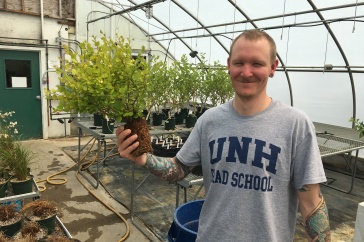

It’s not just about the money.
It may seem that way when looking at the impact climate change could have on New Hampshire’s key tourism industries: The state annually collects $650 million from the ski industry, $484 million from coastal tourism and $292 million during foliage season.
But beyond money, climate change is taking a significant toll on the things we in New England hold dear.

Take fall foliage, already impacted by summer droughts and warmer autumn nights. Data shows sugar maples’ leaves are changing color as many as five days later than they once did.
“Climate change affects the trees’ timing,” says Scott Ollinger, a professor of ecosystem ecology who holds joint appointments in UNH’s Institute for the Study of Earth, Oceans, and Space and the department of natural resources and the environment. “If spring is earlier, summer is warmer and autumn is drier, the timetable will be altered and the likely outcome is you won’t see the short intense burst of color you’re used to.”
“We are already seeing fewer birch, fewer maples, the vibrant color makers,” he says. “Those colors are what create the experience that people love. I don’t know if there ever will be an ‘aha’ moment where they say it’s not the same anymore. But if the season happens two weeks earlier or later, there is a chance they won’t have the experience they’ve had in the past.” That, he adds, could influence the kinds of vacations they plan in the future.
“As sea levels continue to rise there is going to be an impact on our cultural heritage, our maritime heritage — things that matter greatly to many, many people.”
“Climate change is making us reckon with the things we value,” says Meghan Howey, associate professor of anthropology. “As sea levels continue to rise there is going to be an impact on our cultural heritage, our maritime heritage — things that matter greatly to many, many people.” A report from the UNH-based Climate Solutions New England estimates that sea levels will rise between eight inches and more than six feet by the end of the 21st century.
Howey has been looking at how climate change is affecting cultural heritage in places like Portsmouth’s Strawbery Banke and the Wentworth Coolidge Mansion and New Castle’s forts Constitution and Stark, places that hold New Hampshire’s history. All, she says, are at risk of being lost to the sea within 100 years.
“Not even 100 years — these sites are already being impacted,” Howey says. “It’s a matter of coming to terms with what can be lost, of getting people to realize that places they love are going to be gone, and with them, their history. We need to connect the pieces.”
Those pieces are the straight line between climate change and rising ocean levels, more frequent and violent storms, erosion, flooding. “When people start putting it together — ‘Oh, that’s what flooding is about’ — it could make a difference,” Howey says. “One of the reasons people come to Portsmouth is to feel reminiscent, to feel the past. It’s a big economic driver for the area and it’s very vulnerable.”

As is New Hampshire’s ski industry. In recent years, skiers have been experiencing shorter seasons, as their favorite mountains open later and close sooner. The duration and volume of snowpack has changed; warmer temperatures result in less snowpack that melts sooner. The amount of rainfall versus snowfall is increasing, resulting in fewer skiers and dollars: In 2001-02 and 2006-07, lesser snowfall amounts led more than $50 million in lost revenue.
76 Percent of Departments Offer Courses Related to Sustainability
UNH is home to innovative programs that provide a unique, interdisciplinary approach such as the sustainability dual major, the ecogastronomy dual major and the Responsible Governance and Sustainable Citizenship Project.
“If the season starts later, and ski areas miss out on that critical week between Christmas and New Year’s, that can mean 20 percent fewer skier visits and that can spell bad news for their bottom line,” says Elizabeth Burakowski ‘13G, a postdoctoral researcher at UNH and a visiting scientist at the National Center for Atmospheric Research in Boulder, Colorado. In 2012, Burakowski and fellow graduate student Matt Magnusson authored “Climate Impacts on the Winter Tourism Industry in the United States,” a high-profile research report for the Natural Resources Defense Council and Protect Our Winters.
Snowfall is driven by precipitation and temperature. A warmer atmosphere holds more moisture, meaning there could be a span of increased snowfall in the near future. However, the temperature dictates whether it stays on the ground. And records indicate that winters are still getting warmer, according to Burakowski.
“Unfortunately we are already committed to global warming,” says Burakowski. “On average, our winters will be six to eight degrees warmer by 2100. That puts a lot of places above freezing.”
And that freezes out other winter recreation — snowmobiling and cross-country skiing, ice fishing and pond skating — that has been woven into New England’s fabric for decades.

“As winters continue to warm — it’s already happening; it is becoming rarer and rarer to see ponds with ice — those kinds of activities won’t be part of our culture anymore,” says Cameron Wake, research professor of climatology and glaciology and the Josephine A. Lamprey Professor in Climate and Sustainability. He notes that ice-out dates on two of New Hampshire’s largest lakes, Winnipesaukee and Sunapee, are occurring 10 to 20 days earlier than in the past. “What’s dear to me is winter recreation,” he says. “It is such a part of the New England culture and it could be gone.”
But it’s not too late, Wake says. If we can reduce greenhouse gas emissions to below 1990 levels, average temperatures are modeled to rise just four degrees Fahrenheit by the end of the century, half of the increase predicted if fossil fuels remain a primary energy resource, Wake and his collaborators demonstrate in a Climate Solutions New England report on climate change in New Hampshire.
“The sky is not falling,” Wake says. “Some things will disappear and we have to accept that. We can’t protect everything. But if we start now, if we adapt and project out over the next decade, the next two, three, we can spread out the cost. If we wait, it will cost much more. And more will be lost.”
-
Written By:
Jody Record ’95 | Communications and Public Affairs | jody.record@unh.edu



















































